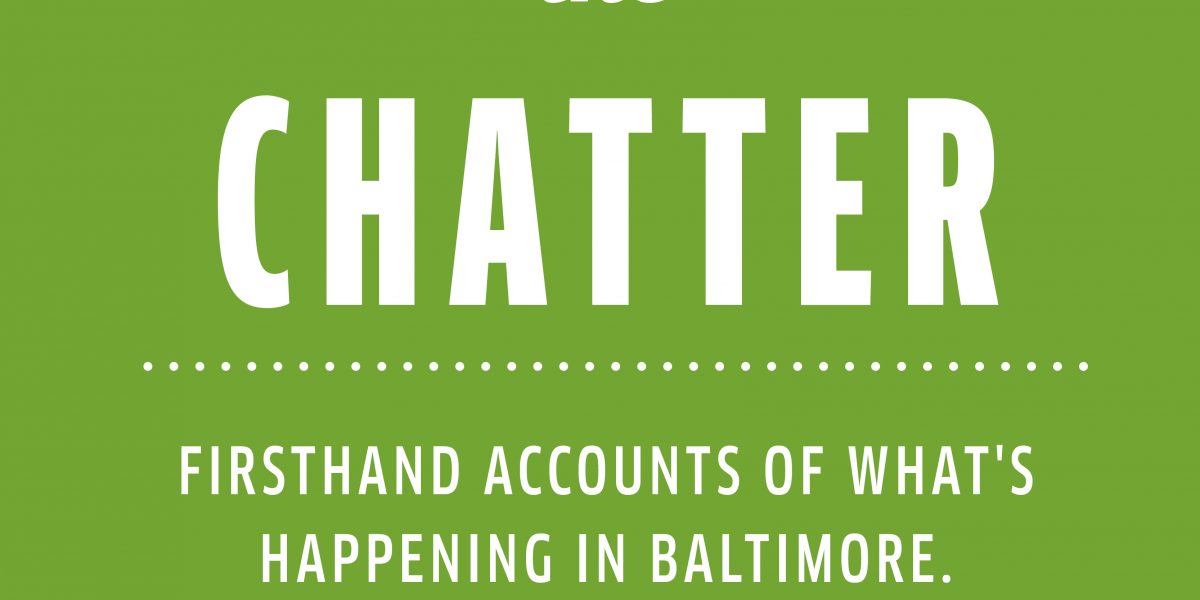News & Community
The Chatter: September 2014
Firsthand accounts of what's happening in Baltimore.
Street Wise
July 11, 2014
North Avenue
Lieutenant Colonel Melvin Russell, the setting sun catching the gold trim of his police hat, is addressing several hundred men at the edge of Leakin Park on a warm Friday night. “This city belongs to all of us,” Russell implores the crowd, preparing for a 9.5-mile anti-violence march from one end of often-notorious North Avenue to the other—and back. “It’s your presence, your being out here, that’s going to turn this city around. You can’t be afraid of the kids that you used to give freeze pops and bags of chips to.”
As sirens and dirt-bike riders known as “12 O’clock Boys” fly past, organizer Munir Bahar, who launched the initial 300 Men March last summer after a string of shootings, adds that change requires time and attention: “Like a slow-cooked meal.”
Then, the men, nearly all African-American, most wearing black “300 Men March” T-shirts with “Baltimore’s Anti-Violence Movement” emblazoned in block white lettering across the back, begin their journey. Onlookers shout and cars honk encouragement as the march’s female supporters hand out water bottles every few miles.
“It gets real when you come back up under I-83 and see that hill, knowing there’s two miles to go,” laughs Ian Smith, his shaved head already glistening. Smith is also keeping tabs on Divine Jones, a Fort Worthington Elementary fifth-grader. “Even when his older brother backed out, he told me he still wanted to do it,” says Anita Harris, his mother, waiting at the Baltimore Cemetery, the halfway point. “We’ve lost a lot of friends and family to violence.”
“He took my walking stick and he was off,” Smith says.
Bird Food
July 13, 2014
Remington Avenue
“Roll lightly. You don’t want to be smashing it into the table,” Charm City Cakes designer Mary Smith cautions her Sunday morning class who are learning the fundamentals of fondant application while competing for tickets and batting practice field passes for tonight’s nationally televised Yankees-Orioles game at Camden Yards.
Meanwhile, soon-to-be-married Orioles season ticketholders Stephen Smeal and Sherry Green are building their masterpieces side by side. He’s playing off the O’s “Birdland Passport” image, which features the Oriole bird holding a bat in each clawed foot, while her more traditional white cake is themed around the Orioles’ 60th anniversary season. Last year, the couple even planned their vacation around the team’s West Coast swing, catching several games in California. “If we win tickets,” says Smeal, “it’ll be our fourth game this week.” (They did; Green’s cake took second place.)
The proceeds from the workshop/cake competition benefit the YAI (Young Adult Initiative) Network, whose fundraising captain, Connie Schwab, has convinced her boyfriend, coincidentally Yankees beat writer Bryan Hoch—now delicately drawing the Yankees’ logo in icing—to take part. Later, using an X-Acto knife, he cuts out a silhouette of the New York skyline and rings the cake in (slightly crooked) navy blue pinstripes. “It’s good,” he says, of his rookie effort.
“Well, it’s your first time, honey,” offers his girlfriend, more objectively.
Afterward, someone suggests he present the cake to outgoing Yankees shortstop Derek Jeter as a retirement gift. “Hey, I haven’t gotten him anything, and I am flying to Minneapolis after this for the All-Star Game,” Hoch says. “I’ll see him there.”
“That’s an idea,” Schwab nods and smiles. “That way it won’t have to come back to New York with me.”
Big Dreams
July 18, 2014
Annapolis
Inside a 210-square-foot, off-the-grid home being built behind The Key School’s administration office, Cameron Salvon-Harman, a rising Key School ninth-grader, pulls a nail from his pouch and drives it into a piece of three-quarter-inch plywood, aiming for the stud. “Crap, I missed,” he says, wiping his brow. Elsewhere on the modest construction site, a dozen middle-school campers in hard hats and safety goggles, are toting lumber, sawing wood, and building bookcases.
The first “Tiny House” built by Maryland students—according to The Key School and SustainaFest, a two-year-old, Annapolis-based sustainability and education nonprofit—the project is designed to teach students about sustainability principles. In the process, SustainaFest president George Chmael II adds, they’re also learning about green design and technology, including solar electricity and rainwater filtration. Each camp day begins with a talk from a local green expert and, ultimately, the home will become a traveling exhibit. Already, Chmael II says, the project has received a great deal of interest, including a call from Good Morning America.
“It’s a little smaller than my bedroom, but I think I could live in a house like that,” says Salvon-Harman. “I’d put it on a barge, make it into a houseboat, and sail it and live on the water for a while. Then I’d hitch it to a trailer and drive across the country—just go anywhere.”
